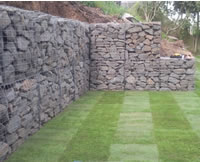
The other day I discovered that the name for those wire cages filled with rocks used in construction and to stabilise river banks, hillsides and shorelines are called gabions. The word comes from the Italian gabbione (big cage), which comes from the Latin cavea (cage).
There are plenty of gabions around here, but I didn’t know what to call them before, apart from wire baskets filled with rocks and stones, or something similar. I find that knowing the name of something makes it so much easier to talk about it – would you agree?
For example, if you go for a walk in the country and want to point out particular flora and fauna that you see, or want to describe what you saw afterwards, it helps if you know the names of things. So instead of saying that you saw some trees, flowers and birds, you might say that you saw oak, beech and ash trees; dandelions, old man’s trousers and buttercups, and so on. Some people, like my mum, could probably give you the Latin names of some of the flora as well.
Knowing the names of things, in your native language, and in other languages you know, enriches your world and enables you to talk about a variety of things without having to resort to paraphrases and long descriptions. The common names of flora and fauna can be interesting and poetic even – for example, the Irish name for fuschia is deaora dé (“God’s tears”). I learnt this word first in Irish, then found out what the plant is called in English.
I’m quite good at the names of birds and animals in English, Welsh, French and Irish, but not so good at plants and trees, which I’m working on.
I too found out the word gabion just some time ago. I happened to see it in a Japanese–English dictionary when looking for something else. I knew it was kivikori in Finnish, because I studied landscape design, but I never knew what it was in English before that. The Finnish word simply means ‘rock basket’.
The Japanese words for it are 蛇籠 jakago ‘snake basket/cage’ and 布団篭 futonkago ‘mattress basket/cage’. I don’t really know why, but I assumed they refer to different usages. The first one would be used when they are used as a line, and the latter when they cover a bigger area, but I don’t know if that is the case.
Fuchsia in Finnish is verenpisara, or ‘drop of blood’. In Japanese they are フクシア fukushia or ホクシャ hokusha, both coming from the English word fuchsia.
I find plant and animal names so interesting that I’m currently compiling a list of them in Japanese, Finnish and English. I like to find out what the literal meaning of the Japanese names are. There are some instances where the Japanese and Finnish names are similar in meaning but the English name is different. Like the pygmy owl (Glaucidium passerinum), in Finnish varpuspöllö (sparrow owl) and in Japanese suzumefukurou (sparrow owl).
“Fuchsia … In Japanese they are フクシア fukushia or ホクシャ hokusha, both coming from the English word fuchsia”
Interesting that fukushia appears to reflect the more ‘correct’ pronunciation of the ‘English’ word (actually a German surname with a Latin ending, but anyway…),/’fʊk sia/, rather than the more common /’fju ːʃə/.
Oh, that’s how it’s pronounced in English? Interesting. Weird.
It’d almost work as material for a pun between “fuchsia plant” and “fusion plant”. Then again, you probably don’t use the word plant when referring to fusion reactors.
The English way to pronounce scientific names (which I never call Latin names) is often quite distinct. I try to pronounce them in a Classical Latin way (albeit with a Finnish accent), even though I just said I don’t like to think of them as actual Latin. But they are mostly Latinised anyway. I use Classical Latin because that’s what I have studied. In any case, this leads to me saying [ɑker] when an English speaking person says [eɪsə(ɹ)]. That’s the maple, Acer.
Rauli, Wikipedia mentions:
Mattress: a form of gabion with relatively small height relative to the lateral dimensions; commonly very wide. For protecting surfaces from wave erosion and similar attack, rather than building or supporting high structures.
So I would guess that the Japanese term 布団篭 (futonkago) refers to the same specialized type of gabion.
Your remarks about scientific names remind me of how relatively prominent a part Latin seems to play in Finnish life (is it still taught in schools at all?). I’m thinking of Finnish Radio (YLE)’s weekly news bulletins Nuntii Latini (“conspectus rerum internationalium hebdomadalis, programma in terrarum orbe unicum”). Not so sure about that claim to uniqueness, though: Radio Bremen also has its Nuntii Latini Septimanales. I find it very interesting to compare and contrast the Finnish- and German-accented Latin!
Kevin, that sounds quite plausible.
Latin is taught in a few upper secondary schools / high schools as an optional subject. I studied it in university.
Even in Finland there are two types of Latin pronunciation. In the University of Helsinki, the vowel combination “ae” is pronounced [eː], while in the University of Turku it is prounounced [ai], which was the pronunciation before it started to turn into a monophthong in the Classical period. I studied in Helsinki.